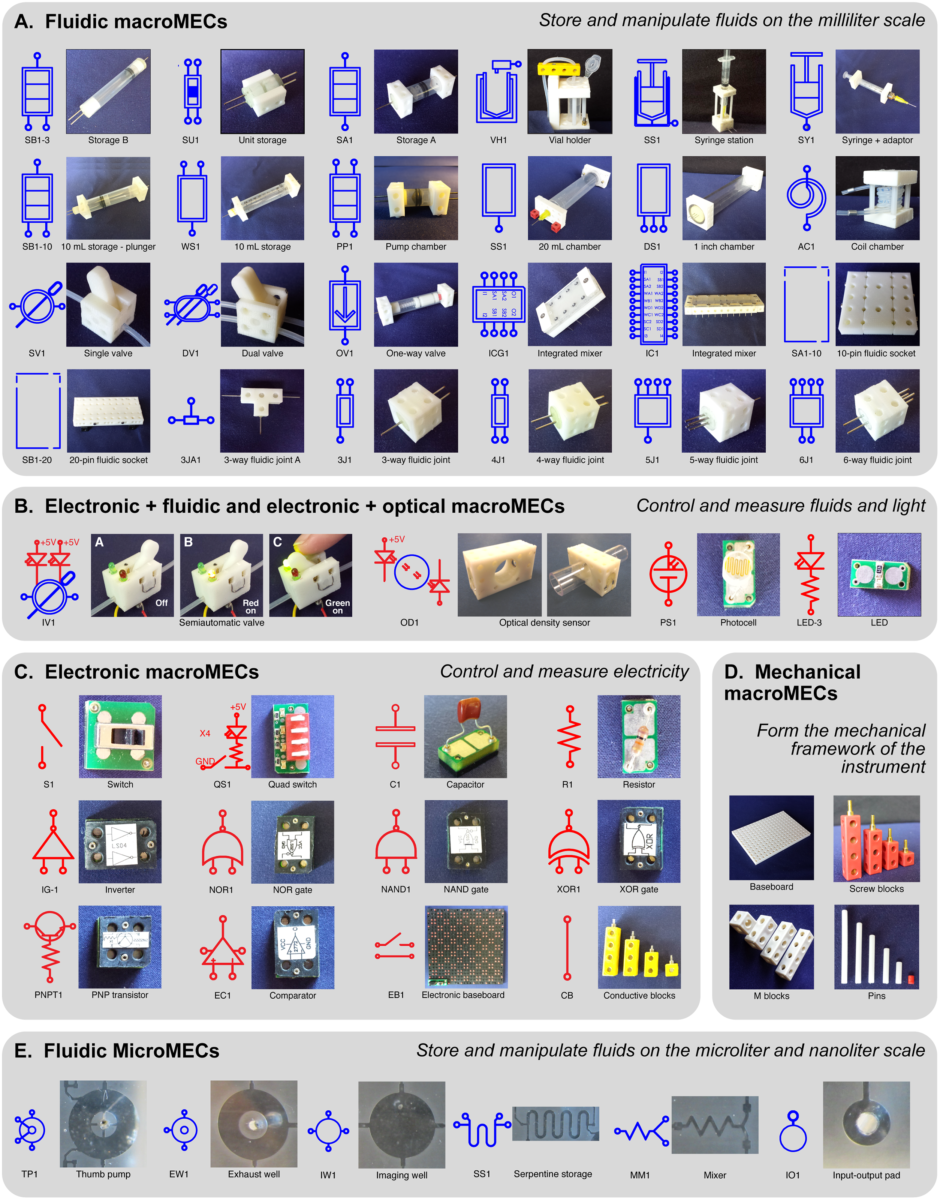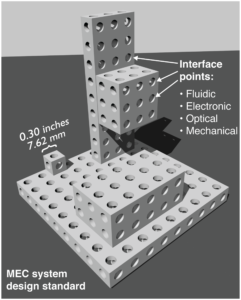Researchers Design LEGO-Like 3D Printable Modular Blocks That Can Be Used to Build Customized Lab Instruments
 If you want to build a basic electronics project it is actually relatively simple to do. Most parts are designed to be modular and work with other parts, and in fact there are entire kits full of random electronic parts that can be used in a wide array of projects and devices. Unfortunately this system of multi-use parts and components doesn’t exist for other disciplines like the life sciences, where lab research equipment needs to be created from scratch for each different experiment. Not only does this add additional time to the project spent creating specialized lab tools, but it can be hard to manage in resource-limited environments like high schools and underfunded labs.
If you want to build a basic electronics project it is actually relatively simple to do. Most parts are designed to be modular and work with other parts, and in fact there are entire kits full of random electronic parts that can be used in a wide array of projects and devices. Unfortunately this system of multi-use parts and components doesn’t exist for other disciplines like the life sciences, where lab research equipment needs to be created from scratch for each different experiment. Not only does this add additional time to the project spent creating specialized lab tools, but it can be hard to manage in resource-limited environments like high schools and underfunded labs.
However a team of researchers and students at the University of California, Riverside have been working on a solution, and it borrows from the concept of standard electronic part design and building block systems like LEGO. When graduate student Douglas Hill joined UCR’s Ph.D. program in Bioengineering, he had already spent years building electronics using components that were intentionally designed to work with each other in a wide variety of ways. He was surprised that there was no similar system of parts or components in place within his new area of study, so he proposed the idea of developing one with William Grover, assistant professor of bioengineering in UCR’s Bourns College of Engineering.
“When Doug came to UC Riverside, he was a little shocked to find out that bioengineers build new instruments from scratch. He’s used to putting together a few resistors and capacitors and making a new circuit in just a few minutes. But building new tools for life science research can take months or even years. Doug set out to change that,” Grover explained to UCR Today.
Typically when researchers in the life sciences need to run an experiment or recreate a biological or chemical reaction they need to develop a custom lab device that will work without influencing the data. But after proposing a set of 3D printable building blocks similar to LEGO that could be used to quickly and cheaply create custom chemical and biological research instruments, Hill and Grover received a grant from National Science Foundation’s Instrument Development for Biological Research program to fully develop it. They published their work in a paper titled “MECs: ‘Building Blocks’ for Creating Biological and Chemical Instruments” authored by Douglas A. Hill, Lindsey E. Anderson, Casey J. Hill, Afshin Mostaghim, Victor G. J. Rodgers and William H. Grover.
A group of UC Riverside undergraduates participated in the development of the various block components by designing new blocks and using existing designs to build functional instruments. The flexible and adaptable blocks are called Multifluidic Evolutionary Components (MECs) and were created to perform a fundamental function that would be needed for the construction of real-world testing and research devices. Tasks as simple as measuring data, micro-pumps, fluid storage and measuring, LED user interfaces, mixing components, sensing modules and parts that stimulate skeletal structures are all considered relatively standard. Because all of the MECs were designed specifically to work with each other, components can be used to quickly construct equipment like bioreactors or devices that measure chemical or biological reactions.
So far more than 50 UCR students have participated in the design and development of the MEC blocks system and have created more than 200 of them. They have also helped design a collection of basic schematics that will guide users in the assembly of MEC building blocks into working instruments. The result is a library of functional components or blocks that can be used in settings as diverse as a high school science class to a world-class research lab to produce virtually any type of research, scientific or diagnostic tools. In order for the blocks to truly be functional across all of the life sciences, the project required that Hill and Grover to work with students from all over the campus from a wide variety of disciplines.
“This is a truly interdisciplinary project—we’ve had computer science students write the code that runs the blocks, bioengineering students culture cells using instruments built from the blocks, and even art students design the graphical interface for the software that controls the blocks. Once the students have created these instruments, they also understand how they work, they can ‘hack’ them to make them better, and they can take them apart to create something else,” Grover continued.
The next step in the MEC development process is a pilot program that Hill and Grover are planning to bring to two California school districts. The blocks will be used to complete recently enacted “Next Generation Science Standards” that are part of a national initiative to improve STEM education in public schools. The relative affordability and high rate of functionality make the MEC Block system ideal for k-12 settings where funding is often limited and science teachers often end up purchasing supplies and components from their own pockets.
“The Next Generation Science Standards require that science teachers provide their students with engineering experiences, but sometimes that’s hard for teachers to do, especially in biology and chemistry classes where they might not have the tools they need. By using our blocks, the students can receive an engineering experience by designing, building, and refining their instruments, and also a science experience as they use their instruments to learn about biology and chemistry,” Grover said.
Once the testing and evaluation of the MEC Block system has been completed and the blocks are ready to be used in standard lab settings Hill and Grover plan to make the affordable system widely available. Because the blocks are 3D printable they could be easily accessed by schools in underserved communities, nonprofits and even developing nations. This week Hill and Grover published their MEC Block research and data in the science journal PLOS ONE, which you can access here. Discuss further over in the 3D Printed Modular Life Sciences Equipment forum at 3DPB.com.
[Source/Video: UCR Today / Images: UC Riverside via PLOS ONE]
Subscribe to Our Email Newsletter
Stay up-to-date on all the latest news from the 3D printing industry and receive information and offers from third party vendors.
You May Also Like
Air Force Awards Fortius Metals $1.25M to Qualify 3D Printing Wire for Hypersonic Applications
AFWERX, part of the US Air Force Research Laboratory (AFRL), awarded a Direct-to-Phase II Small Business Innovation Research (SBIR) contract worth $1.25 million to Colorado’s Fortius Metals, to accelerate qualification...
US Air Force Awards JuggerBot $4M for Large-format Hybrid 3D Printing
Large-format 3D printer manufacturer JuggerBot has received a $4 million grant to develop a large format 3D printer, courtesy of the Under Secretary of Defense, Research and Engineering Manufacturing Technology...
Where Have All AM’s Unicorns Gone?
In the rapidly evolving world of 3D printing, startups valued at over a billion dollars, known as unicorns, once seemed as fantastical as the mythical creatures themselves. While a few...
How My Childhood Fascination with Planes Led to Investing in 3D Printing
My fascination with aerospace started young, and I started studying planes–identifying them in the sky and learning everything I could about how they work. Fast forward to my first week...



































